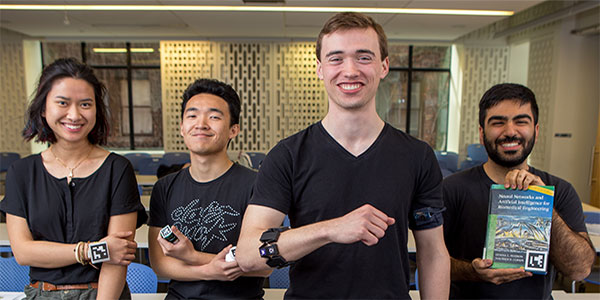Photo: “Neural Engineering Tech Studio” winners, Os(eye)ris
UW’s Center for Sensorimotor Neural Engineering recently reported on “Neural Engineering Tech Studio,” a course offered by the Department of Bioengineering (BIOEN 461/561) that offers students the opportunity to invent technologies that have the potential for real-world clinical and commercial impact. Over 10 weeks, undergraduate and graduate students team up to brainstorm solutions that address problems experienced by people living with sensory impairment, cognitive challenges and other sensorimotor conditions.
The plan, design and build prototypes, and present their devices to a team of academic experts and industry leaders at the end of the quarter. The winning team receives seed funding and incubation space at the CSNE to develop their invention.
They also receive guidance on how to bring their product to market. “The hope isn’t that they commercialize it right away, because it’s not likely to be ready for that yet,” explained Lise Johnson, the course’s instructor and CSNE university education manager. “We’d like to see them take it to the UW Business Plan Competition, or the Amazon Catalyst Competition or one of the many other entrepreneurial events around campus that would provide them with even more funding and support.”
This year’s winning team, Os(eye)ris, created a wearable camera designed for visually-impared individual that assists in finding commonly used objects at home. Customized, printed fiducial markers are used to tag common items for identification at later times. When voice-activated by the user, the camera will turn on and sense objects tagged by these markers.
“You can say, ‘Hey, help me find my water bottle,’ and Os(eye)ris will search for the water bottle with the specific marker attached,” said team member Armin Rouz, a bioengineering undergrad. “It will give you an auditory beep or vibratory haptic feedback using a Myo™ band in order to help you move toward that object. A higher-frequency beep or haptic feedback means that you are closer to the object. It’s a way to help the user find things around their house that they might have trouble seeing.”
Os(eye)ris identifies objects for the user
… And later helps the user find the objects
Other projects developed by the students included:
• AEGIS: A plug-and-play alternative gaming controller that uses electromyography (EMG) signals for graded control, creating an intuitive and immersive gaming experience.
• Focus Frames: A wearable neurosensory device that detects engagement level, strengthens innate attention, and trains focus.
• Grasp Independence: An orthotic grasping mechanism for stroke survivors with hemiparesis who desire to perform independent tasks that require dual hand dexterity.
• Hawkulus: A wearable input modality for controlling a smartphone with eye movements, producing intuitive, hands-free device operation.


